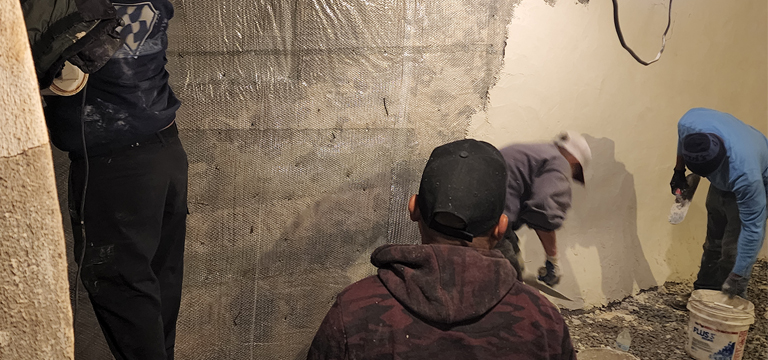Basement “sweating,” or condensation forming on your basement walls, is a common but often misunderstood issue. When warm, humid air meets the cooler surface of concrete walls, tiny droplets of water form, leaving walls damp and clammy. Over time, this can lead to mold growth, musty odors, and damage to finishes or stored belongings. Understanding why basement walls sweat and knowing how to stop it can help protect your home and maintain a healthy environment.
Why Basement Walls Sweat
Before you can fix the problem, it’s important to understand what’s causing it. There are two primary sources of moisture in basements, which are condensation and water intrusion.
- Condensation (Sweating) happens when humid indoor air touches a cold basement wall. The temperature difference causes water vapor in the air to turn into liquid droplets.
- Water Intrusion occurs when groundwater seeps through cracks, gaps, or porous concrete due to poor drainage or hydrostatic pressure.
To determine which problem you have, tape a square of clear plastic wrap tightly to the wall and leave it for 24–48 hours. If moisture forms on the room side of the plastic, the issue is condensation. If it appears behind the plastic, water is seeping through the wall. If your basement walls are truly “sweating,” the steps below can help you reduce or stop the problem.
Key Ways to Prevent Basement Wall Sweating
- Control Indoor Humidity
Excess humidity is the leading cause of sweating walls. Aim to keep your basement’s relative humidity below 50%.
- Use a dehumidifier sized appropriately for your basement.
- Make sure clothes dryers and exhaust fans vent outside, not into the basement.
- Avoid storing wet or damp items, such as firewood or laundry, in the basement.
- Open basement windows when the air outside is cooler and drier than indoors.
- Improve Air Circulation and Temperature
Poor airflow allows humid air to linger near cold walls. Improving circulation helps balance temperature and reduce condensation.
- Use fans to keep air moving throughout the basement.
- Slightly heat the basement during colder months to prevent walls from becoming too cool.
- Avoid pressing insulation or drywall directly against concrete. Leave an air gap to allow moisture to evaporate.
- Check Exterior Drainage and Grading
Even if your condensation is primarily caused by indoor humidity, excess moisture around your foundation can make things worse.
- Make sure gutters and downspouts are clear and direct water at least six feet away from your home.
- Re-grade the soil around your foundation so it slopes away, preventing water from pooling near basement walls.
- Install splash blocks or downspout extenders to help move runoff farther from the foundation.
- Seal Cracks and Gaps
Moisture often enters through small cracks or openings where pipes or cables pass through basement walls.
- Use hydraulic cement or masonry sealant to patch visible cracks.
- Seal around wall penetrations with appropriate waterproof caulking.
- For recurring leaks along the joint where the wall meets the floor, consider having an interior drainage channel installed.
- Insulate Properly
Insulation helps keep wall surfaces warmer, reducing the temperature difference that causes condensation.
- Apply rigid foam board insulation directly to basement walls before framing them.
- Avoid using fiberglass batts against concrete. They absorb moisture and can promote mold.
- Do not install plastic vapor barriers directly against concrete walls, as they can trap moisture.
Step-by-Step Plan to Stop Basement Wall Sweating
Here’s a simple plan for managing the problem effectively:
- Identify the cause – Determine whether the moisture is condensation or seepage.
- Control humidity – Use a dehumidifier and proper ventilation.
- Improve drainage – Keep water away from your foundation with gutters and grading.
- Seal cracks – Patch or repair visible openings.
- Insulate wisely – Use moisture-resistant foam insulation to keep walls warmer.
- Monitor regularly – Check for condensation during humid months.
- Call a pro if needed – If sweating or dampness persists, contact A Waterproofing Solution for a permanent fix.
When to Call a Professional Waterproofing Contractor
If you’ve tried managing humidity and still notice persistent dampness, it’s time to bring in a professional. What might look like simple sweating could actually be a symptom of groundwater intrusion or foundation issues.
That’s where A Waterproofing Solution comes in. We specialize in identifying and resolving all forms of basement moisture problems, from condensation to serious seepage.
Professional Waterproofing Services from A Waterproofing Solution
A Waterproofing Solution serves homeowners throughout southeastern Pennsylvania, New Jersey, and Delaware. Our team provides comprehensive inspections, long-term waterproofing systems, and lifetime guarantees on many of their installations. Financing options are also available for homeowners seeking affordable moisture control.
Keep Your Basement Dry and Comfortable
Sweating basement walls might start as a minor annoyance, but ignoring the problem can lead to costly repairs down the road. By controlling humidity, sealing leaks, and improving drainage, you can stop condensation before it becomes a bigger issue. If you’re still struggling with damp or musty basement walls, contact A Waterproofing Solution for expert waterproofing services. Our team can identify the root cause of your moisture problem and implement a customized system to keep your basement dry, healthy, and protected for years to come.


